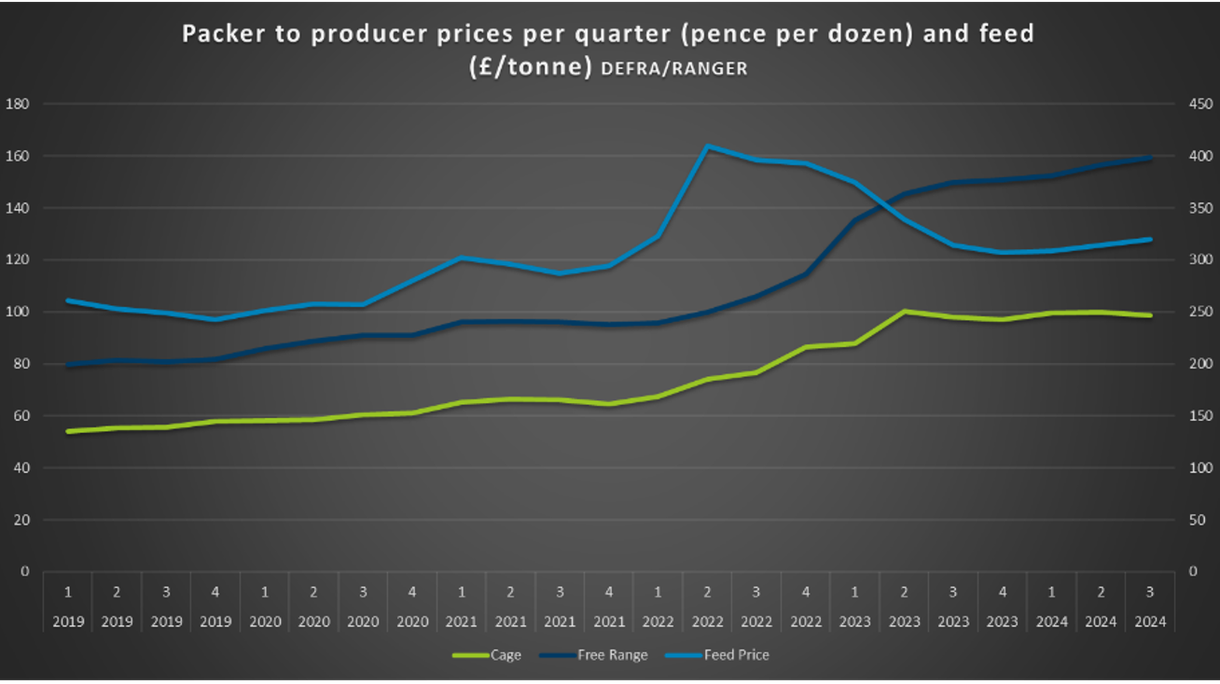
Published on Jan. 7, 2025
Nick Bailey Looks Forward to 2025
Nick Bailey of Joice and Hill looks forward to 2025 with this message “Let’s keep the industry profitable, celebrate the move to white eggs and keep our heads when improving welfare.”
Over the last twelve months, the UK egg industry has enjoyed a sustained period of profitable trading and positivity. As a sector, we benefit from involvement in the production of a highly nutritious, healthy, versatile and sustainable food - enjoyed by millions of consumers every day.
The value chain we all contribute to deserves and needs to be profitable if we are to sustain innovation, investment and recruitment, while covering the inherent production and sales risks.
Healthy innovations in branding and products
Over the last fifteen years, retailer activity and market dynamics have propelled a proliferation of egg packers. This has created healthy innovations in branding and products, enhancing competition. At the same time, the number of subscribers sitting around the Lion Code table has multiplied.
Up until 2022, eggs were plentiful, and retailers were able to play suppliers against each other, to lower prices. Whilst this was positive for consumers in the short term, it placed the supply chain under considerable tension, which came to a head after the invasion of Ukraine and the subsequent impact on energy and feed prices. Many retailers demonstrated an aloofness to this crisis which led to a dramatic fall in replacement flocks and resulted in egg shortages. Then, the advantage retailers had gained from the proliferation of packers reversed, driving them to compete for the available egg supply.

Ensuring supply and demand remains balanced
Margins for producers increased, but it took a while to forget the painful experience of 2022. Planning consent issues and increases in build costs acted as a brake, pausing the expansion trend in free range. In 2024, buoyed by producer margins and long-term packer contracts, free range expansion restarted. As we look forward to 2025, we must now be careful not to overdo this and ensure supply and demand remains balanced.
Any suggestion of over supply is likely to be exploited, and margins will once again be undermined. As I write, egg supply is tight in the UK and Europe, keeping wholesale prices high. As we go past Easter 2025, demand will drop, and the large number of hens reported to have been culled in exporting country Poland will probably have been replaced. After the recovery from a low point of 34 million in 2022, annualised UK chicks placed had been stable at 37 million. In the last two months this has increased by 1 million.

Producers should choose their white breed carefully
One of the key trends in 2024 has been the continued increase in white egg layer flocks and they now represent more than 10% of all UK laying hens placed. Retailer and consumer acceptance has increased, and we are now well past the description of niche or “only selling because of egg shortages”. This follows a trend seen elsewhere in Europe where white leghorns overtook brown hybrids as markets swung from cage to free range or aviary systems. Some strains of white leghorn are much better adapted and more resilient to free range and aviary systems than their brown sisters. The benefit to producers’ stress levels in managing white over brown flocks should not be underestimated. It should be noted that the greater genetic diversity amongst white breeds means producers should choose their white breed carefully to get these benefits.
Improving our industry based on science
Longer cycles and better feed conversion increase sustainability in a world that increasingly looks to the carbon footprint of our food. On retail shelves, white eggs give an entry point product to replace the colony offering and a base for higher priced standard and premium free-range offerings to sit on.
Lastly, a call to ensure we continue improve our industry based on science, reason and the needs of the consumers we serve, and not on politics or dogma. We have been supporters of the RSPCA backed assurance scheme and the genuine benefits it has brought to animal welfare. However, recent changes to standards leave us questioning the direction of travel. The German KAT system has had windows to allow daylight into poultry houses for some time, but this principally covers barn aviary systems and not free-range systems that dominate the UK. The standard appears to try to keep up with KAT and is entirely anthropomorphic in its basis. Hens do benefit from the UVA present in sunlight in terms of recognition of individuals, litter use etc. However, windows act as a UVA filter, and we would be much better providing this via lighting technology.
Please also allow patience with hatcheries in our answer to the male chick question. We are motivated and active in finding a solution, but it needs to be the right one, to limit additional costs whilst keep operational issues practical. Current commercialised methods are slow, relatively late in the incubation process and costly. It is ethically questionable to add a huge amount of cost to a food staple such as eggs during a cost-of-living crisis, especially when the males in question form a valuable part of the food chain for keepers of raptors and reptiles. If we did not supply this need, something else will be reared and killed in their place, possibly in much less controlled conditions. The UK already imports males to supply this market. If we remove this product and leave it to others to supply it, we need to be sure it’s the right solution to bring benefits to all.
Nick Bailey - Managing Director, Joice and Hill Poultry Ltd
December 2024
